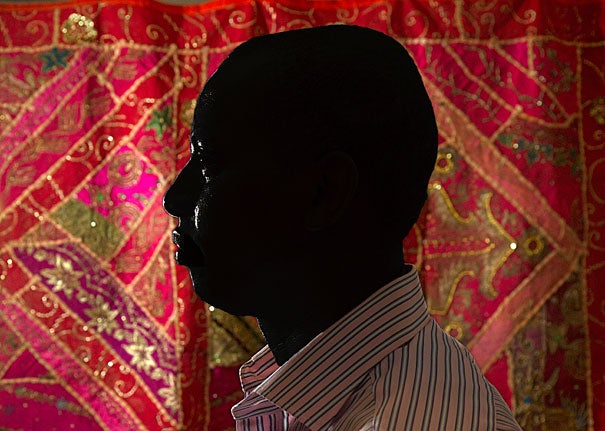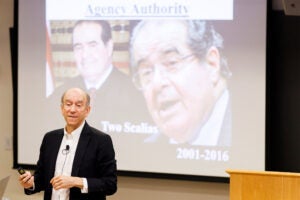
For two years, Jean-Paul (not his real name) worked with lawyers and law students at the Harvard Immigration and Refugee Clinic. Finally, in May, Jean-Paul was granted asylum by the Boston Immigration Court.
Jon Chase/Harvard Staff Photographer
The long journey to asylum
Harvard law clinic defends rights of those who might have none in homelands
One afternoon in late July, a 39-year-old African man we will call Jean-Paul took the elevator to the third floor of Harvard Law School’s (HLS) Wasserstein Hall. He walked into the Harvard Immigration and Refugee Clinic and was greeted like a hero.
By one definition, Jean-Paul qualifies as such. He’s an African Odysseus whose long journey and personal trials include a family massacre, days of torture, months of fearful hiding, and a thriller-like escape from his native Burundi.
In the classics, a hero also returns home, but for Jean-Paul — now employed at a Boston parking garage — there is no going back. The United States is now his home. When he arrived in Washington, D.C., as an exile in 2006, he had a visa, two changes of clothes, and $5.
Jean-Paul’s next test of strength started a month later, with his legal appeal for asylum. This legal status guarantees aliens some “protection from return” to a native land where imprisonment and even death might await them.
On May 30 of this year, Jean-Paul finally was granted asylum in Boston Immigration Court. Helping him during the last two years were lawyers and law students at the Harvard clinic. They worked for months with Jean-Paul, listening to his story, helping him to overcome his trauma, honing his testimony, gathering a yard-high stack of legal paperwork, and arguing the final case in court. When the judge declared that Jean-Paul was granted asylum, he was stunned yet ecstatic. He turned to his main lawyer and said, “This is my day.”
That lawyer was Emily B. Leung, trained at Boston University and the clinic’s Albert M. Sacks Clinical Teaching and Advocacy Fellow. Working with her this spring on Jean-Paul’s case were Summer Moore-Estes, HLS ’13, and Marie-Claire O’Kane, LLM ’12, an Irish graduate of the University of Oxford who is now studying law in London.
In July, Leung greeted Jean-Paul at the elevator. It was his first visit to the clinic since getting asylum. The next time he would bring a gift. “We don’t need any gifts,” she said. “That’s our reward: that we won and you get to stay.”
Asylum’s practicalities
For asylum seekers, the process of getting to stay can take from two to six years, said Deborah Anker, clinical professor of law and director of the Harvard Immigration and Refugee Clinic. She is also author of the legal text “Law of Asylum in the United States” (2011), which has gone through multiple editions in the last two decades.
As many as 50 Harvard law students work in the clinic every year. Each works on two to five cases a semester. Some cases are like Jean-Paul’s; others involve violence against women, or juveniles in need of special immigration status. Interest is so high that last year students started a related legal-aid group, the Harvard Immigration Project.
Students not only perform the good work of asylum law, said Anker, but they acquire valuable practical lawyering skills, including polishing affidavit writing and interview techniques, developing court arguments, and gathering expert testimony. (For Jean-Paul’s case, the clinic called in volunteer experts in post-traumatic stress and Burundi’s troubled civil affairs.)
The clinic experience — personal, practical, and immediate — counters the more typical world of legal studies, which is “very 2-D,” said O’Kane, where everything is “just in the book, just in theory.”
Moore-Estes agreed. “Clinical work combines the legal pedagogy of the classroom with real-life clients,” she wrote from her summer internship in New Orleans. It creates “an atmosphere that allows you to learn the law and actually apply it.”
Besides, she said, the clinic work often meant “immediate humanitarian relief for an individual who has suffered gross human rights violations.” Moore-Estes said of Jean-Paul: “The perseverance he brought to the process was a powerful reminder of the resilience of the human spirit.”
Anker has marveled for decades at the strength of her clients, and their ability to move beyond horror and embrace hope. “This is the most important part of the work,” she said, “working with these incredible clients and watching them bloom.”
They bloom despite language barriers. Jean-Paul’s English is getting stronger, but his Burundi languages are French, Swahili and his native Kirundi. Since 1984, when the clinic opened, clients have streamed in from all over the world, speaking a United Nations of languages. But hope is one language they all share. In a conference room hangs a fanciful map of the world painted last summer by clinic workers and their clients. It includes the words, “A place to call home.”
The conference room itself, snug and book-lined, was a home of sorts for Jean-Paul this spring as clinic lawyers spent months with him there sharpening testimony and crafting a written statement. “This room, I like so much this room,” he said during his visit. “I spent most of my life in this room. Many people helped me a lot here.”
Legally there are five grounds for U.S. asylum, involving persecution for race, religion, nationality, political opinion, and membership in a particular social group (including sexual orientation and gender). Such persecution can come from a government or from a non-state party from which the government does not provide protection. The best example of that, said Anker, involves women fleeing domestic violence in countries where gender abuse is common or where laws are not enforced.
U.S. asylum law and its five foundations are complex, contested, and mutable, said Anker.
Client testimony often provides the most critical evidence in establishing what Anker called the key to any asylum case: “well-founded fear.”
For Jean-Paul, such fear is finally fading. “I had many bad memory on me,” he said, remembering his first moments in the United States. “I was thinking many things. I didn’t be happy. It took me many years, and it changed slow by slow.”
Asylum’s start in suffering
Burundi is an impoverished, landlocked African nation wracked by famine, poor education, and civil unrest. Only half of the adult men are literate, and a quarter of the women. There are three doctors for every 100,000 people. Two percent of families have bank accounts. And looming over everything is ethnic strife that has killed hundreds of thousands in Jean-Paul’s lifetime. Since the 1970s, political power has swung back and forth between the two major ethnic groups, the Hutu and the Tutsi.
In the summer of 2006, Jean-Paul, an ethnic Tutsi, was 34 and operating a trucking business in Bujumbura, Burundi’s capital. One morning, he stepped outside his rental house to meet two men who had stopped by to do business. Would he go with them for a cup of tea? It was the Burundi way.
Jean-Paul got into their car. But instead of tea, he got three days and two nights in the office of the security forces. He was kicked, beaten with plastic batons, and threatened with a knife held to his neck, he said. Too often, critics say, the security forces practice deceit, detention, torture, and accusation — usually based on ethnic divisions and politics. The security forces, all Hutu, asked Jean-Paul the same question over and over: What was his role in the coming coup d’état? Hutu presidential authorities were certain that Tutsi opposition leaders were plotting one. “They beat me, they beat me, they beat me,” said Jean-Paul.
Jean-Paul said he had no role in a plot to overthrow the government. And events would soon show there was no such plot. But he understood the vagaries of ethnic violence. Seven years before, in a remote provincial town, Hutu rebels had raided his childhood home and massacred his entire family. “I was living good, with my parents and my brothers,” Jean-Paul said of his life before Dec. 2, 1999. “We were loving each other.”
On the morning of the third day of his detention in 2006, the police let Jean-Paul go, but on one condition: Come back every two days with information on the plot. He limped across the street to a public phone and called his best friend. The next day that friend went to Jean-Paul’s house. Hand grenades had been tossed through the bedroom widow and exploded, so there was little to save. Jean-Paul hid from the police for two months, and eventually managed to secure a visa. At the airport, a $100 bribe proffered by the same friend got him past security.
A day later, Jean-Paul arrived in the United States.
“It is hard to make a life,” he said. “You don’t speak the language. You don’t know if you’re going to get a job. Even the food is different.” And the Northeast climate adds another challenge, said Jean-Paul, whose tropical homeland includes the source of the Nile River. Snow is pretty, he said simply, but “it’s cold.”
Still, there is the rule of law in the United States, along with safety, medicine, and food, coupled with a chance to make a living in peace. In the end, only waiting for a legal resolution proved truly hard. “If they don’t agree to asylum, it’s like death,” said Jean-Paul. “Where will you go?”
Finding a refuge
Once a person gains asylum in the United States, he or she is eligible to apply for a Green Card after a year. But asylum is just for a lucky few, said Anker. It was not even memorialized in U.S. Law until the Refugee Act of 1980, though it has been an ideal since the 18th century and a treaty obligation since 1968.
“Asylum is what America is about,” Anker said. “This is a land that gives refuge to the oppressed. It’s so much a part of our identity as a nation.”
At the same time, the more common path to citizenship — immigration — is harder than ever to follow, especially for those who transgress U.S. law even slightly. “The laws have generally gotten hideously narrow,” said Anker, “and the grounds for deportation have expanded astronomically.” (Since the start of the Obama administration, said Leung, there have been about 400,000 deportations a year.)
But countering these trends is a “long tradition of an activist bar” in the United States, said Anker, who began her career as a civil rights lawyer in Boston.
The clinic is at the tip of a legal spear, a salvation for a lucky few like Jean-Paul. “There’s a lot of interest in human rights work, but this is very concrete,” said Anker of asylum law. “It’s human rights in action.”




